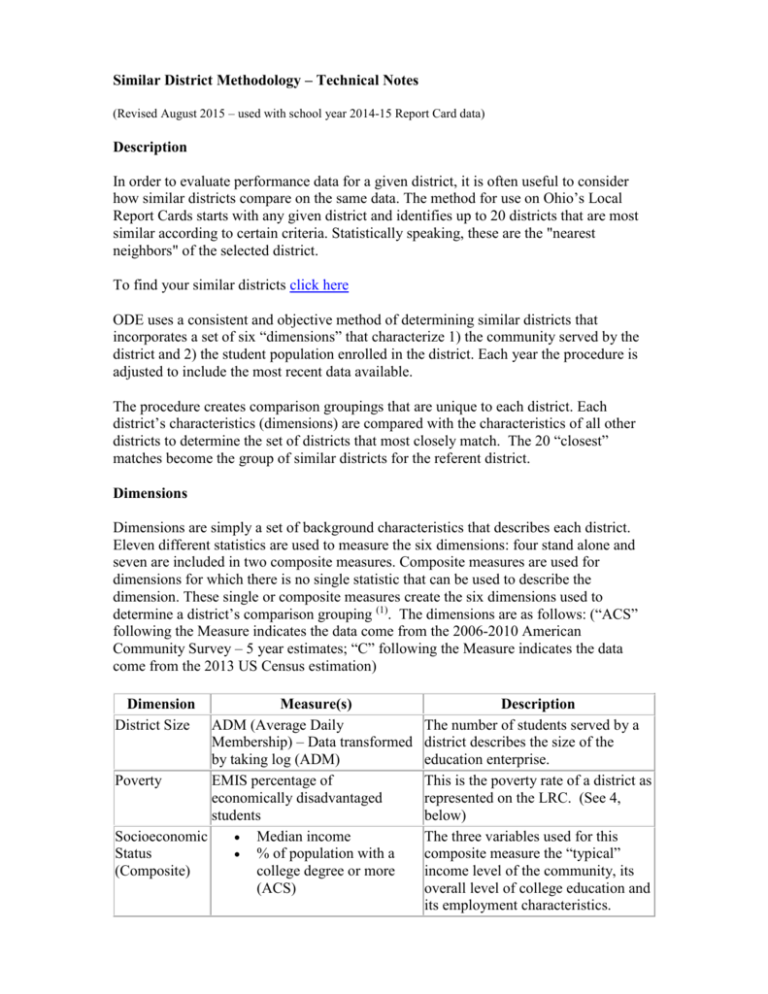Similar District Methodology (WORD)
advertisement

Similar District Methodology – Technical Notes (Revised August 2015 – used with school year 2014-15 Report Card data) Description In order to evaluate performance data for a given district, it is often useful to consider how similar districts compare on the same data. The method for use on Ohio’s Local Report Cards starts with any given district and identifies up to 20 districts that are most similar according to certain criteria. Statistically speaking, these are the "nearest neighbors" of the selected district. To find your similar districts click here ODE uses a consistent and objective method of determining similar districts that incorporates a set of six “dimensions” that characterize 1) the community served by the district and 2) the student population enrolled in the district. Each year the procedure is adjusted to include the most recent data available. The procedure creates comparison groupings that are unique to each district. Each district’s characteristics (dimensions) are compared with the characteristics of all other districts to determine the set of districts that most closely match. The 20 “closest” matches become the group of similar districts for the referent district. Dimensions Dimensions are simply a set of background characteristics that describes each district. Eleven different statistics are used to measure the six dimensions: four stand alone and seven are included in two composite measures. Composite measures are used for dimensions for which there is no single statistic that can be used to describe the dimension. These single or composite measures create the six dimensions used to determine a district’s comparison grouping (1). The dimensions are as follows: (“ACS” following the Measure indicates the data come from the 2006-2010 American Community Survey – 5 year estimates; “C” following the Measure indicates the data come from the 2013 US Census estimation) Dimension District Size Measure(s) ADM (Average Daily Membership) – Data transformed by taking log (ADM) Poverty EMIS percentage of economically disadvantaged students Socioeconomic Median income Status % of population with a (Composite) college degree or more (ACS) Description The number of students served by a district describes the size of the education enterprise. This is the poverty rate of a district as represented on the LRC. (See 4, below) The three variables used for this composite measure the “typical” income level of the community, its overall level of college education and its employment characteristics. Rural/Urban Continuum (Composite) % of population in administrative/professional occupations (ACS) Population density % of agricultural property Population (C) Incorporation of a city larger than 40,000 (C) This composite uses four variables to create a continuous measure that distinguishes school districts that have urban characteristics from those that have more rural characteristics. % of students enrolled reported as African-American, Hispanic, This is a measure of the racial/ethnic Native-American, or Multiracial. Race/Ethnicity diversity of the student population in Data transformed by taking log the district. (base 10). If % is less than 1%, log is set at “0”. NonThis is a measure of community's Agricultural Per-pupil amount of commercial, ability to generate revenue for and Nonindustrial, mining, tangible, and schools-separate from its residential Residential public utility property (or agricultural) tax base. Tax Capacity How the data are analyzed Each district is compared to 609 other districts by performing a comparison across all dimensions (2). The result is a “distance” between each pair of districts. The smaller the “distance,” the more similar the two districts are. For each district, the 20 “closest” districts are selected as its group of similar districts. In some cases, the distance between a district and its closest neighbors is very large. In these cases, there can be fewer than 20 “similar districts” reflecting the unique features of the referent district. Limitations Developing similar district comparison groupings is a process that enables individual districts to conduct meaningful comparative analysis. Despite the benefits to this approach, there are limitations to the use of the methodology. The concerns that impact these limitations are outlined below. 1. The method does not include a geographical dimension. Many districts tend to compare themselves with surrounding districts. The similar district method does not necessarily include geographically close districts in the given district's performance comparison grouping because neighboring districts might not truly be the most similar districts in the state. On the other hand, expenditure patterns (expenditures per pupil, salary information, etc.) tend to reflect regional conditions. Thus, a better way to compare financial data is to select districts that are geographically close. 2. The method deliberately selects the “nearest” 20 districts as the standard for comparison. But some districts are more “unique” than others. In some cases (typically very large cities), “distances” to other districts are so large that a cut-off point needs to be established in the distance metric, which limits the comparison group to fewer than 20. An arbitrary minimum number of similar districts for any district is five. It is also true that some districts tend to look like many other districts, so the cutoff of 20 similar districts captures those districts that are extremely similar according to the chosen dimensions. In this case, districts can closely resemble many other districts beyond the cutoff of 20. Small, rural districts often fall into this category. 3. Generating unique comparison groupings can produce seemingly counter-intuitive results if inter-grouping comparisons are made. Stated another way, laying out several similar district groupings side by side and making comparisons across several groupings may be tempting but is not appropriate given the method. The following example illustrates why this is so. Tables 1, 2, and 3 (below) contain FY2015 comparison groupings for Southwestern City, Lakewood City, and Reynoldsburg City. Note the following: Lakewood and Reynoldsburg both appear in Southwestern’s comparison groupings. Southwestern appears in Lakewood’s comparison grouping (but not in Reynoldburg’s). Lakewood and Reynoldsburg do not appear in each other's comparison groupings. This occurs because each district's comparison grouping is unique to itself and contains only the 20 “nearest” districts (maximum). Comparisons across similar groupings are not appropriate because the similar grouping method establishes like districts for a given district ONLY. Southwestern is statistically similar to both Lakewood and Reynoldsburg. While Lakewood’s list includes Southwestern but not Reynoldsburg, Reynoldsburg’s comparison grouping includes neither Southwestern nor Lakewood. 4. Starting with the data for school year 2007-08, the percent poverty measure is the rate reported through EMIS using the economic disadvantagement flag. In prior years this measure was based on poverty counts reported by the Ohio Department of Job and Family Services pursuant to ORC 3317.10. These are two different (although highly correlated) measures and caution should be taken in comparing the two. Questions For questions or comments, contact: Matthew Cohen, Chief Research Officer Office of Policy and Research Ohio Department of Education 25 S. Front Street, 4th Floor Columbus, Ohio 43215 (614) 752-8729 Matt.Cohen@education.ohio.gov (1) Tests for relationships between data elements were conducted with each variable prior to the analysis of dimensions. Data representing each dimension were normalized prior to the analysis, with means equal to zero and standard deviations of 1. This process standardized the metric used for comparative purposes so that each district can be fairly compared with any other district. (2) The formula for each district-to-district comparison is as follows. Where A, B, C, D, E, and F represent dimension values; i represents the district of interest; and j represents the district being compared to that district, then the distance “O” between two districts is calculated as: O = ((Ai-Aj)2 + (Bi-Bj)2 + (Ci-Cj)2 + (Di-Dj)2 + (Ei-Ej)2+ (Fi-Fj)2) 1/2 Table 1 - Southwestern FY 2015 Comparison Grouping 1 2 3 4 5 6 7 8 9 10 11 12 13 14 15 16 17 18 19 20 Southwestern City CSD Northwest Local Washington Local Fairfield City Hamilton City Parma City Elyria City Newark City Huber Heights City Willoughby-Eastlake City Plain Local Kettering City Groveport-Madison Local Findlay City Euclid City Canton City Berea City Westerville City Lakewood City Fairborn City Reynoldsburg Franklin Hamilton Lucas Butler Butler Cuyahoga Lorain Licking Montgomery Lake Stark Montgomery Franklin Hancock Cuyahoga Stark Cuyahoga Franklin Cuyahoga Greene Franklin Table 2 - Lakewood FY 2015 Comparison Grouping 1 2 3 4 5 6 7 8 9 10 11 12 13 14 15 16 17 18 19 20 Lakewood City SD Cuyahoga Falls City Parma City Plain City Kettering City Northwest Local Fairfield City Westerville City Huber Heights City Willoughby-Eastlake City Findlay City Washington Local Fairborn City Berea City Cleveland Hts-University Hts City Newark City West Clermont Local South Western City Mentor Exempted Euclid City Oak Hills Local Cuyahoga Summit Cuyahoga Stark Montgomery Hamilton Butler Franklin Montgomery Lake Hancock Lucas Greene Cuyahoga Cuyahoga Licking Clermont Franklin Lake Cuyahoga Hamilton Table 3 - Reynoldsburg FY 2015 Comparison Grouping 1 2 3 4 5 6 7 8 9 10 11 12 13 14 15 16 17 18 19 20 Reynoldsburg City Huber Heights City Northwest Local Plain Local Northmont City Fairborn City Springfield Local West Carrollton City Winton Woods City Austintown Local Findlay City Licking Heights Local Fairfield City Xenia Community City South Euclid-Lyndhurst City Delaware City Mad River Local Kent City Garfield Heights City Groveport-Madison Local Canal Winchester Local Franklin Montgomery Hamilton Stark Montgomery Greene Lucas Montgomery Hamilton Mahoning Hancock Licking Butler Greene Cuyahoga Delaware Montgomery Portage Cuyahoga Franklin Franklin








